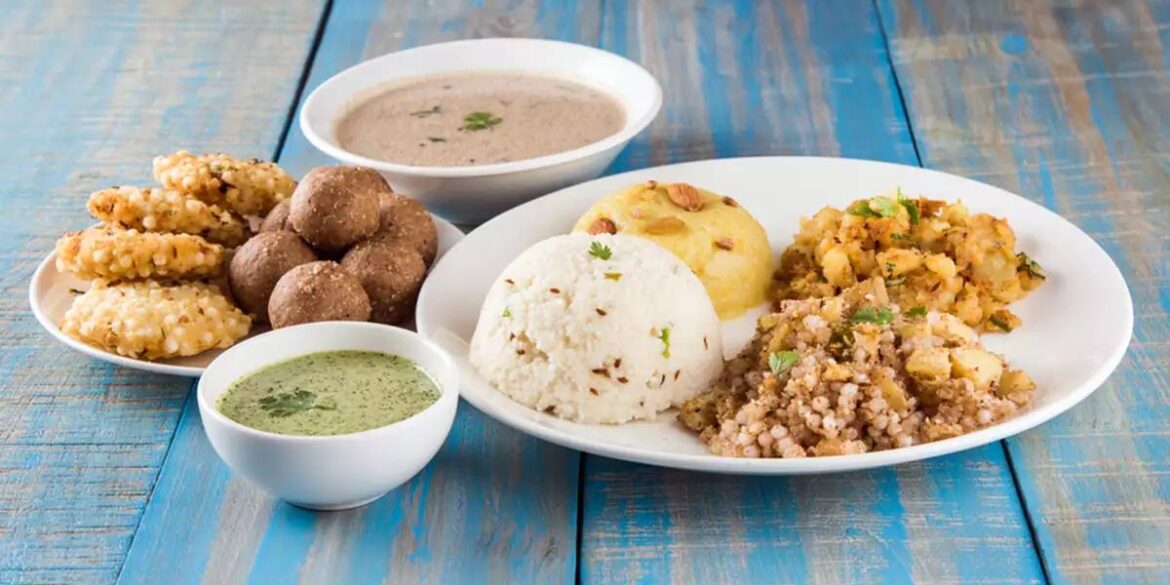Nourishing Navratri: Yogic Meal Ideas for the Sacred Festival
During the auspicious period of Navratri, devotees across the globe come together to honor the divine feminine energy and engage in spiritual practices like fasting, prayer, and meditation. As we embark on this sacred journey, we’re sharing Navratri meal suggestions endorsed by Hansaji, Director of The Yoga Institute and President of the Indian Yoga Association. These delectable dishes not only adhere to fasting traditions but also promote a yogic lifestyle, enhancing physical and mental well-being.
By incorporating these Navratri meal options into your fasting routine, you can harness the transformative power of this sacred festival to strengthen your yoga path. These dishes pay homage to tradition while nourishing your inner light.
RAJGIRA THALIPEETH
Ingredients:
- 1 cup Rajgira (amaranth) flour
- ¼ cup grated boiled sweet potatoes
- ¼ cup fresh coriander leaves, finely chopped
- Sendha namak (rock salt) to taste
- ½ tsp cumin seeds (jeera)
- ½ tsp black pepper powder (optional)
- Ghee or oil for cooking
Instructions:
- Prepare the Veggies: Grate the boiled sweet potatoes and chop fresh coriander leaves. Set them aside.
- Make the Thalipeeth Dough: In a mixing bowl, combine the Rajgira flour, grated sweet potatoes, chopped coriander leaves, cumin seeds, black pepper powder (if used), and Sendha Namak (rock salt). Knead the mixture into smooth dough. You can add a little water if needed, but usually, the moisture from the potatoes is sufficient to form the dough.
- Divide and Shape the Thalipeeth: Partition the dough mixture into small portions and shape them into balls. Flatten each ball to form a round, flatbread (Thalipeeth) on a plastic sheet or parchment paper. You can moisten your fingers slightly to prevent sticking.
- Cook the Thalipeeth: Heat a griddle or skillet over medium-high heat and grease it with ghee or oil. Carefully transfer the shaped Thalipeeth onto the hot griddle. Cook until both sides are golden brown and crisp, drizzling more ghee or oil around the edges as needed.
- Serve Hot: Remove the Rajgira Thalipeeth from the griddle and serve it hot with yogurt, Vrat ke aloo (potato curry), or your preferred fasting chutney.
BARNYARD MILLET PATTIES:
Ingredients:
- 1 cup barnyard millet (samak rice), cooked and cooled
- 2 medium-sized potatoes, boiled and mashed
- ¼ cup roasted peanuts, coarsely crushed
- ¼ cup fresh coriander leaves, finely chopped
- Sendha namak (rock salt) to taste
- ½ tsp cumin seeds (jeera)
- Ghee or oil for pan-frying
Instructions:
- Prepare the Barnyard Millet: Cook the barnyard millet (samak rice) and let it cool completely.
- Mix Ingredients: In a mixing bowl, combine the cooked millet, mashed potatoes, crushed peanuts, finely chopped coriander leaves, Sendha Namak (rock salt), and cumin seeds (jeera).
- Shape the Patties: Divide the mixture into small portions and shape them into patties or tikki according to your preference.
- Pan-Fry the Patties: Heat a non-stick skillet or pan and add ghee or oil for shallow frying. Place the millet patties in the hot pan and cook them on medium heat until they become golden brown and crispy on both sides.
- Serve Hot: Once the patties are cooked and crisp, remove them from the pan and place them on a paper towel to remove excess oil/ghee. Serve the barnyard millet patties hot with yogurt or your preferred fasting chutney.
ARBI SAUTE
Ingredients:
- 250 grams arbi (colocasia)
- 2-3 tbsp ghee or oil (use ghee for a sattvic option)
- 1 tsp cumin seeds (jeera)
- ½ tsp ajwain seeds (carom seeds)
- Sendha namak (rock salt) to taste
- ½ tsp black pepper powder (optional)
- ½ tsp roasted cumin powder (optional)
- Fresh coriander leaves for garnish
Instructions:
- Prepare the Arbi: Wash the arbi (colocasia) to remove any dirt. Boil the arbi until they are soft and easily pierced with a fork (around 15-20 minutes in a pressure cooker). Peel the cooled arbi and cut them into rounds or cubes.
- Temper the Arbi: Heat ghee or oil in a pan and add cumin seeds (jeera) and ajwain seeds (carom seeds). Let them sizzle for a few seconds.
- Add Arbi: Add the boiled and peeled arbi to the pan, stirring well to coat them with the tempered spices.
- Seasoning: Sprinkle sendha namak (rock salt) over the arbi. You can also add black pepper powder and roasted cumin powder for additional flavor (optional).
- Cook Until Crispy: Cook the arbi on medium-low heat
, stirring occasionally, until they turn golden brown and crisp on the outside, which typically takes about 10-15 minutes.
- Garnish and Serve: Garnish with fresh coriander leaves and remove from heat.
- Serve Hot: Present the crispy Arbi sauté immediately as a side dish for your fasting meal.
These Navratri meal ideas, shared with us by Hansaji, offer a delightful fusion of tradition and nourishment, supporting your spiritual journey during this sacred festival. May your Navratri be filled with divine blessings and inner illumination.
The information contained in this post is for general information purposes only. The information is provided by Navratri Meals: Embracing A Yogic Lifestyle Through Nourishing Dishes and while we endeavour to keep the information up to date and correct, we make no representations or warranties of any kind, express or implied, about the completeness, accuracy, reliability, suitability or availability with respect to the website or the information, products, services, or related graphics contained on the post for any purpose.


